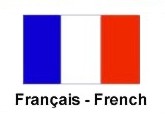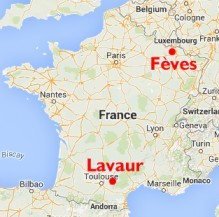Left: One of the Canrobert Forts on the Fèves ridge; right: The black arrows show the route followed by the 378th Infantry Regiment in capturing the ridge and liberating the village of Fèves. The blue line is the location of the regiment on the morning of November 15.
Deception was employed. Some men from the 378th Infantry Regiment were left at the base of the ridge. Their orders
were to be especially active and visible. The idea was to make the German observers believe the whole force was still at
that location.
Then, during the early morning of November 15, the remainder of the 378th circled around the northeast corner of the
ridge. They expected that if all went well, they would have Fort de Fèves neutralized in four days.
While the attack began at 8 a.m., it was over just three hours later. Fèves, the small village just southeast of the fort,
was liberated at that time.
With the poor visibility produced by rainy overcast days in the fall of 1944, bombs often landed in the village, producing
much unintended damage.
Early in the war when the area had been seized by the Germans, many of Fèves' citizens had been expelled to Lavaur and nearby
villages in southwestern France. After Fèves' capture by Patton's army, many decided to return. But life in Fèves was hard.
They found their village 75 percent destroyed.
During German occupation, many Fèves citizens were
deported to Lavaur
and other small nearby villages.
One can not realize what stuff these French people must be made of to come back to what was once their city and smile and really start life from what we would call below scratch. It takes plenty of nerve, but that is what these people have.
T5 Rolland R. Vaughan
44th Combat Engineers
Sept. 26, 1944
Letter to family
Vaughan, far right, listens to Patton, far left.
Six months later, the war in Europe was over. Soldiers were withdrawn rapidly to fight against Japan.
But a story of war damage was not unique to Fèves or Europe. Britain, one of the victors, suffered great hardships. Food
rationing would go on for 10 years after the Allied victory.
Left and center: Fèves in 1949. Right: bomb damage near London's Victoria Street Station





